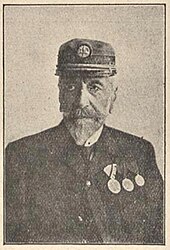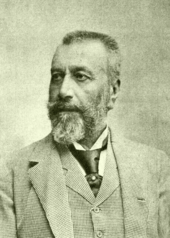Johann Nepomuk Wilczek

Johann Nepomuk Graf Wilczek (* December 7, 1837 in Vienna ; † January 27, 1922 there ), known as Count Hanns Wilczek , was an Austrian polar explorer and patron of the arts .
Life
Count Wilczek studied archeology , art and natural history and went to South Russia , the Crimea and the Caucasus in 1863 . As a volunteer he took part in the German War in 1866 . He traveled to Africa between 1868 and 1870 .
Hans Wilczek was the most important sponsor of the Austro-Hungarian North Pole Expedition of Julius Payer and Carl Weyprecht from 1872 to 1874. With his money, the schooner S / X Admiral Tegetthoff was built and the extensive equipment required for the expedition was purchased.
In 1872 he was also head of the Second Isbjörn Expedition , the purpose of which was to build a coal and provisions depot for the polar expedition. After Isbjörn and Tegetthoff met by chance and a food depot was set up on the coast of the Barents Island, the Isbjörn reached the Pechora estuary, from where Wilczek traveled on through Russia on the Pechora and Volga and arrived back in Vienna on November 9th. Wilhelm Burger traveled with him as a photographer .
In the further course of the Austro-Hungarian North Pole Expedition, the crew of Tegetthoff - now enclosed by the pack ice - discovered a group of islands further north in 1874 and, after initial explorations, gave it the name Kaiser- Franz-Joseph-Land . The northernmost island received the name of Crown Prince Rudolf as Rudolf Island , two others were called Wilczek Island and Wilczek Land .
After two hibernation periods (only one was planned), the entire team of around 30 men, only the machinist Otto Krisch died of an illness, returned to a safe harbor on Novaya Zemlya by means of makeshift boats and was received triumphantly in Vienna in the summer of 1874.
From 1875 Wilczek was president of the Austrian Geographical Society and advocated the establishment of a temporary Austro-Hungarian research station as part of the First International Polar Year 1882/1883 . He equipped the station on Jan Mayen Island at his own expense . From 1881 he was a member of the Numismatic Society Vienna.
The Imperial and Royal Army Museum (now the Army History Museum ) in Vienna found a special sponsor in Count Wilczek. Under the chairmanship of Crown Prince Rudolf and Archduke Wilhelm , he was a member of the committee founded in 1885, which was responsible for the formation and design of the museum, which was opened on May 25, 1891 by Emperor Franz Joseph. At the opening ceremony, Wilczek personally showed the emperor through the showrooms.
From 1874 and 1906 Wilczek had Kreuzenstein Castle near Vienna , which was destroyed in the course of the 30-year war and then largely demolished as building material, rebuilt as a show and museum castle for his extensive art collections. In 1886 he acquired Moosham Castle .
Wilczek was a non-profit organization and had the Rudolfinerhaus built in Vienna together with Theodor Billroth , and the Vienna Voluntary Rescue Society and the Vienna Student Convict.
Johann Nepomuk Graf Wilczek died on January 27, 1922 in Vienna and found his final resting place under the chapel of Kreuzenstein Castle .
family
Since 1858 Wilczek had been married to Countess Emma Emo-Capodilista (1833-1924), a lady-in-waiting of Archduchess Sophie . They had four children together. But regardless of this, Wilczek was an admirer, as was Emperor Franz Joseph , of Katharina Schratt , as one could see from love letters from 1886.
A great-great-grandson of Wilczek is the ruling Prince of Liechtenstein Hans-Adam II.
Appreciation
In 1932 Wilczekgasse in Vienna- Favoriten was named after him.
Portraits:
- 1907 cast bronze plaque, 208: 142 mm, 70th birthday. Medalist: Rudolf Marschall
- 1907 silver and bronze plaque, 65:44 mm, 70th birthday. Medalist: Rudolf Marschall
- 1917 bronze medal, 66 mm, 80th birthday. Medalist: Josef Tautenhayn Junior
literature
- Julius Payer : The Austro-Hungarian North Pole Expedition in the years 1872–1874, together with a sketch of the second German North Pole expedition 1869–1870 and the polar expedition of 1871 . With 146 illustrations (wood engravings) and 3 (folded) maps. Vienna: Hölder 1876. CIV, 696 S. ( online )
- Constantin von Wurzbach : Wilczek, Johann Nepomuk . In: Biographisches Lexikon des Kaiserthums Oesterreich . 56th part. Kaiserlich-Königliche Hof- und Staatsdruckerei, Vienna 1888, pp. 118–122 ( digitized version ).
- Imperial Academy of Sciences : Austrian polar station Jan Mayen, equipped by his Excellency Count Hanns Wilczek, led by KK Corvette Captain Emil Edlen von Wohlgemuth. Observation Results, 3 volumes. Vienna 1886, I. Bd. , II. Bd., I. Abt. , II. Vol. II. Div. , III. Vol. Or III. Vol.
- Andreas Pöschek : Secret North Pole. The Austro-Hungarian North Pole Expedition 1872–1874. - Scientific work 1999 ( as PDF for download )
- Hermann F. Koerbel: History of the Austrian polar research . - Vienna: Arctic Research Consortium Austria, 2003. - ISBN 3-9501733-0-7
Web links
- Entry on Johann Nepomuk Wilczek in the database of the state's memory of the history of Lower Austria ( Museum Niederösterreich )
- Entry on Johann Nepomuk Wilczek in the Austria Forum (in the AEIOU Austria Lexicon )
- biography
Individual evidence
- ^ Heeresgeschichtliches Museum (Ed.): 100 Years of the Heeresgeschichtliches Museum. Known and unknown about its history . Heeresgeschichtliches Museum, Vienna 1991, p. 8 f.
- ↑ "I feel your kisses so warm so hot - Kathi you ... drank my blood" on the website of the Federal Monuments Office , accessed on September 12, 2011.
| personal data | |
|---|---|
| SURNAME | Wilczek, Johann Nepomuk |
| ALTERNATIVE NAMES | Wilczek, Hans Graf; Wilczek, Johann Nepomuk Graf |
| BRIEF DESCRIPTION | Austrian polar explorer and patron of the arts |
| DATE OF BIRTH | December 7, 1837 |
| PLACE OF BIRTH | Vienna |
| DATE OF DEATH | January 27, 1922 |
| Place of death | Vienna |

